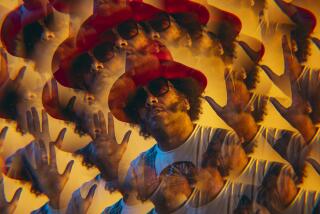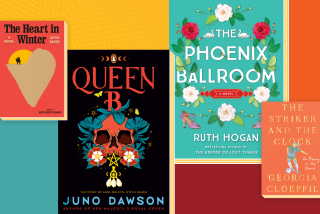Talking with Joshua S. Raab about theNewerYork
Joshua S. Raab means to provoke us. His Santa Monica-based journal theNewerYork seeks a new way of engaging with literature; even to call it a journal, he might say, is to miss the point.
Visit the website and you’ll see what he means. theNewerYork exists as a print annual — pocket-sized, featuring short works by writers such as Steve Almond, Les Plesko and Stephen Jay Schwartz; Book III is just out. But that’s just one iteration. There’s also the EEEL, or Electronic Encyclopedia of Experimental Literature, a set of virtual broadsides featuring single texts accompanied by art, as well as a monthly print subscription series called thePaperEEEL.
“The dream,” Raab explains, “is that when somebody submits a short fiction to theNewerYork then BOOM that story is now in a book, graphically designed on a poster, adapted into a short film, performed at one of our literary carnivals. At some point it becomes the art of storytelling but we will remain literary publishers, in all forms.”
Recently, we corresponded, via email, about theNewerYork.
TheNewerYork has just put out its third issue. How did it come about?
General discontent. Kind of like the musicians who say they make their music because it is music they want to listen to but couldn’t find. I was so sick of literary magazines claiming they published “the finest in contemporary literature.” I had come across enough experimental writers of repute and I figured there must be some unknowns looking for someone to publish their weirder works. I wanted to be that someone. We don’t publish the finest literature, but we might publish the weirdest. Literature was boring me but I still loved it, so I made theNewerYork.
You’re adamant about standing apart from forms such as the novel or the poem; rather, you publish what you call “short-fictions.” Can you explain?
A short-fiction is anything with words that has a discernible narrative. It is a blanket term that could include short stories and poems. For us, however, it also includes Craigslist ads, flash fiction, faux artifacts, lists and so on. We publish this work because, simply, there are enough short stories and poems. Visual art and music have been unabashedly experimental and paradigm shifting. From Marina Abramovic to Banksy to the rise of dubstep, music and visual art have been running at the future open-armed. There is a world, a universe, we have not yet explored with the written word and narrative. And these writers, hidden in their rooms around the world and country, are writing these weird looking, weird reading fictions, and there is no one to read them, no one to publish them. To me, these people are the future of writing.
You quote Shelley in your “Shy Prologue”: “[W]e are thankfully shielded, most of the time, from the miracle of life. Otherwise, the unfathomable yet certain truth of life would overwhelm and break us.” How does writing fit in?
Good writing should shake us out of complacency: “Bullet to the Brain” by Tobias Wolff, “The Laughing Heart” by Bukowski, “A Modest Proposal” by Jonathan Swift, even “The Communist Manifesto” or Dr. Seuss! These texts force us to think differently, if only for a moment. Reading itself will not lift you out of complacency, but it gives you the tools. That is, it helps you take the first step to acting differently: thinking differently. You don’t have to agree with the words, you simply have to let down your guard, let your internal narrative be taken over for a bit, rather than constantly judging and responding.
At the heart of such an intention is the idea that reading matters. But we live in a culture where that is very much in question.
I admit we are in part becoming an “aliterate” society; we know how to read but choose not to, opting to sift through videos and TV. I like to think our little books trick you into feeling like you’re watching YouTube videos, but the reality is you’re delving into narratives, and you’re doing it on your own. Reject the institution that tells you publishing and reading are dying. If you don’t reject it, it will come true.
Where do you see theNewerYork going? The three issues you’ve put out have a certain consistency, even down to the Disclaimer at the front.
After the Disclaimer page has been xeroxed beyond recognition, we will release however many books we’ve done as a box set, and start the cycle over with new rules, a new look. In the first two books we had a rule that no piece could be longer than a single spread, but in Book III, one piece was so good (“Flipbook” by Christine Gosnay), we had to break our rules and put it on four pages. We will probably never break our “no photography in the books” rule, though.
You make some strong points about the timidity of literary culture and argue that it’s time to leave nostalgia — for forms, for ways of publishing — behind. How does theNewerYork embody such a challenge?
We try to experiment with publishing as much as we try to experiment with literature. We entreat readers to distribute our books by hand, we crowdfund online, we would never file as a not-for-profit, our books are measured to fit in Levi’s back pockets, our submissions are blind (anonymous; no headlining authors) and we don’t do readings. If publishing is failing and readership is down, then you’ve got to change the chemistry or else let it die.
We recently added donate links to every piece on our website, so if you like the work, you can donate directly to the author. Why doesn’t every website have this? There are ways to generate money, profit, commerce and art that are simply not being explored by an otherwise capable literary community.
Each book reads as if it has its own internal narrative. How intentional is that?
It unfolds naturally. As submissions come, our editors mark the pieces that stand out; we return to them after reviewing the bulk of submissions. We then look for a theme. For instance, in Book II there were submissions mentioning or focused around clowns. Other pieces seemed to have hints of insanity, neuroses and separation from reality. So we began curating for pieces that fit this theme of madness. We took our favorite piece about clowns, split it into three parts and had it divide the sections of the book. This way, Part I, II, and III of the piece seemed to thread all the stories together. With Book III, for whatever reason, it came rather naturally that the theme would be the concept of time.
Often, we shift pieces and spreads around until the last minute, adding, removing and replacing art and stories. But the order is very intentional. We like to start with a sobering, relatively simple story. Then quickly the book falls into some crazy pieces, some longer pieces and what are called “breathers.” We also like to have a combination of serious, silly, funny and weird work. We try to find the balance between experimental and obtuse. If this is going to work, it’s got to be unpretentious. Each book’s last story is a more traditional, longer story, with the final phrase or sentence disjointed and displayed huge on the last page.
On the back cover of Book III, you post a challenge: Be More Alarming.
I’m simply trying to stir the pot! So often we get stuck into the cult of personality or institution: Dostoevsky is good writing, the Gagosian Gallery shows good art. These are not truths, they are opinions. I’m trying to provoke the rejection of “sacred art” and the promotion of agitating and experimental work. To me, experimental fiction is characterized by the possibility of failure.
Don’t be afraid to offend. That doesn’t mean be offensive, it means don’t let yourself be caged in. If it feels right, do things that alarm other people. Push their corners in and turn that square into a circle.
ALSO:
Talking with Karolina Waclawiak about making L.A. a character
Lisa Lyons and Gary Kornblau on the closing of their imprint BuK
Tosh Berman on the band Sparks and the meaning of being a fan
More to Read
Sign up for our Book Club newsletter
Get the latest news, events and more from the Los Angeles Times Book Club, and help us get L.A. reading and talking.
You may occasionally receive promotional content from the Los Angeles Times.








